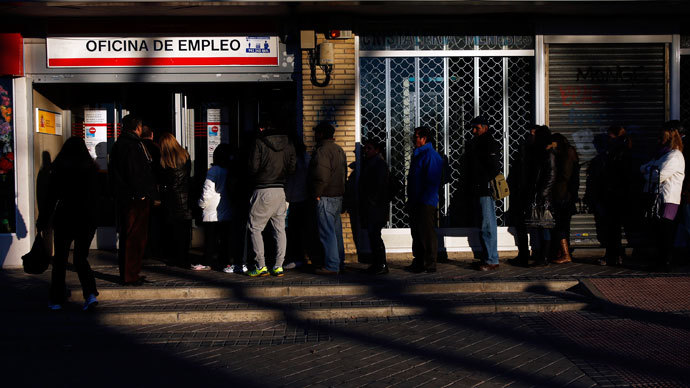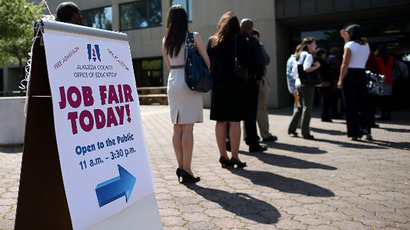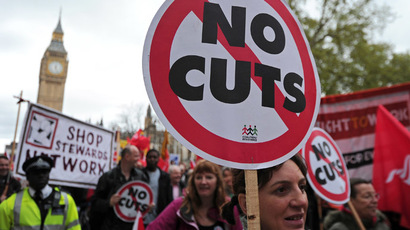Jobs or rallies: Youth unemployment major worry for EU summit

Record high youth unemployment in the EU, where a quarter of under-25s are out of work, has prompted yet another Brussels summit. Analysts warn the 6-billion-euro budget injection isn’t a safe bet and jobless youngsters could be headed for mass protests.
The 5.6 million unemployed young people in Europe have been referred to as the ‘lost generation’. While those aged between 18 and 25 have no jobs, the situation is even worse in Greece and Spain, where over half of people in that age group are jobless.
“You have to do something with these young kids. They are on the street for example in Greece. The youth unemployment makes up 3.3 percent of GDP. This is a tremendous amount of money that needs to be put into these young kids in order to prevent them from going to the streets. They understand that things have gone wrong in this country, they know that the system needs to change definitely, that structural reforms need to be made and that they need to take their fate into their own hands,” president of the Hayek Institute in Vienna, Dr. Barbara Kolm, told RT.
Kolm says the current European political structures are doing nothing to tackle the problem of the overall youth jobless rate reaching 23 percent.
“The labor laws that we have seen in Europe are not flexible at all and they really do not support employment. As a matter of fact, they are against employment. If no right measures are taken, it could get worse.”

While the EU agreed in April to re-target 6 billion euro to offer a "guarantee" of a job, training or apprenticeship within four months of someone becoming unemployed or leaving formal education, many think the measure alone isn’t sufficient enough.
"Six billion euros over seven years and for 28 countries is too small - even if the youth unemployment problem is not that pressing in some countries like Germany," a policy expert at a Bruegel think-tank, Zsolt Darvas, told Reuters.
Even though overall unemployment is lower in Scandinavia, Sweden's jobless rate being 8.7 percent, far below the EU average of 11 percent, young people still make up the bulk of the unemployment rate.
"It's not possible to create jobs in a recessionary environment - you need growth to pick up," an economist Carsten Brzeski explained.
According to a UN body responsible for promoting work and employee rights, the ILO, the EU would need up to 21 billion euro over the same period to reduce the current youth unemployment rate.
Eurofound, an EU agency whose goal is to improve working and living conditions estimates the cost of youth unemployment in Europe at over 150 billion euro a year in lost earnings and taxes, as well as unemployment benefit and other welfare payments.
EU leaders hope a program of training and apprenticeships, using a model that has proved a success in Austria, could help them make a dent in the record rate of unemployment.
Austria boasts the lowest unemployment in the EU at less than 5 percent, according to the EU statistics agency Eurostat. The country has long used training as a practical way to get fresh graduates into jobs. By partially-subsidizing the employment the government also gives employers the confidence - as well as a good reason - to hire.

A similar program has also proved a success in Germany where companies have been given incentives to offer young people one-year learning contracts that help them move into full-time jobs.
"There are many tools that can help, such as various training programs, internships, tax breaks for hiring the unemployed," Zsolt Darvas said. "Yet it is economic growth that can really help address the crisis," he added.
Young people in Europe have been hit hard by the recession with only 33.6 percent employed in 2011, the lowest figure ever recorded, according to Eurofound. Since the start of the recession, youth unemployment has risen by 1.5 million, reaching 5.5 million in 2011. Meanwhile, 7.5 million young people aged 15–24 and an additional 6.5 million young people aged 25–29 were not in employment, education or training. To compare: In 2008, the figure stood at 11 percent of 15–24 year olds and 13 percent of 25–29 year olds. By 2011, however, these had increased to 13 percent and 15 percent respectively.
There are also huge variations between countries, with rates for 15-24 year olds varying from around 7 percent in Luxembourg and The Netherlands to above 17 percent in Bulgaria, Greece, Ireland, Romania, Italy and Spain.
A package of about 1.5 billion euro of European and national funds is currently being released to finance a measures aimed at getting some 200,000 young Italians into work.
Most of the money will be spent in the poverty-stricken south of the country, but will ease the employment of people on temporary contracts throughout Italy, as well as boost training, internship and school-leaver schemes, AFP reported.














